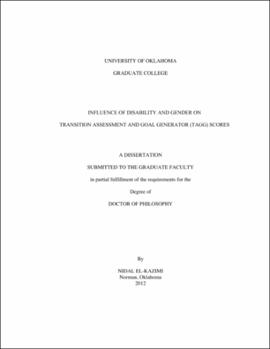| dc.contributor.advisor | Martin, James E. | |
| dc.creator | El-Kazimi, Nidal | |
| dc.date.accessioned | 2019-04-27T21:34:12Z | |
| dc.date.available | 2019-04-27T21:34:12Z | |
| dc.date.issued | 2012 | |
| dc.identifier | 99308168102042 | |
| dc.identifier.uri | https://hdl.handle.net/11244/319036 | |
| dc.description.abstract | Legislators mandated transition education for students with disabilities to improve their post-school outcomes. Each student with an IEP should have an annual transition plan at or before his or her 16th birthday. IDEA mandated the utilization of age appropriate transition assessment to develop students' post-secondary transition goals based on students' strengths and preferences, mediated by needs, and developed in part by attainment of annual transition goals. The Transition Assessment and Goal Generator (TAGG) is currently under development to assess students' non-academic behaviors associated with post-school success and to provide prioritized annual transition goals. | |
| dc.description.abstract | The purpose of this study was to explore the influence of students' gender and students' disability on the TAGG's full scores and TAGG's domain scores across the Professional, Family and Student TAGG versions. By utilizing multivariate statistical analysis tests, the study examined the variations in the TAGG scores across the three versions and domains that are accounted for by student's gender and student's disability. | |
| dc.description.abstract | The participants were 349 high school students with disabilities, 271 family members, and 39 professionals who completed the TAGG assessments for 349 students with disabilities from seven states. Findings from multivariate analysis of variance revealed substantial influence of disability categories on TAGG full scores and TAGG domain scores across the three TAGG versions. Disability category statistically accounted for variation on seven out of the eight domains on the Professional TAGG version, seven out of the eight domains on the Family TAGG version, and four out of the seven domains on the Student TAGG version. Generally, disability categories such as emotional disturbance, autism, and intellectual disabilities scored lower than students with specific learning disabilities and other health impairments. | |
| dc.description.abstract | Regarding gender, results revealed no significant differences on the overall TAGG full scores across the three versions, and on the Professional TAGG Full scores. On the other hand, gender significantly accounted for variation on the Family TAGG version, the Student TAGG version, one out of the eight domains on the Professional TAGG version, three out of the eight domains on the Family TAGG version, and one out of the seven domains on the Student TAGG version. | |
| dc.description.abstract | Findings from this study provided a piece in the process of accumulating validity-related evidence for the TAGG, and emphasized the need to develop a set of modified secondary transition education interventions that are sensitive to the unique characteristics and needs of each gender and disability category. | |
| dc.format.extent | 164 pages | |
| dc.format.medium | application.pdf | |
| dc.language | en_US | |
| dc.relation.requires | Adobe Acrobat Reader | |
| dc.subject | Students with disabilities--Psychology | |
| dc.subject | Vocational evaluation | |
| dc.subject | School-to-work transition | |
| dc.subject | Youth with disabilities--Vocational education | |
| dc.title | INFLUENCE OF DISABILITY AND GENDER ON TRANSITION ASSESSMENT AND GOAL GENERATOR (TAGG) SCORES | |
| dc.type | text | |
| dc.type | document | |
| dc.thesis.degree | Ph.D. | |
| ou.group | Jeannine Rainbolt College of Education::Department of Educational Psychology | |
